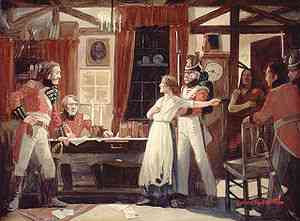Battle of Beaver Dams |
||
|---|---|---|
| Date | Thursday, June 24, 1813 | |
| Weather | Cool and overcast - 63 degrees | |
| Location | Thorold, Ontario | |
British Empire |
United States |
|
| Belligerents | United Kingdom | The United States of America |
| Commanders | Unknown | Charles G. Boerstler, George Armistead |
| Casualties |
Force: 450 Killed: 11 Wounded: 25 Captured: 0 |
Force: 625 Killed: 25 Wounded: 50 Captured: 462 |
|
BackgroundOn May 25, 1813, the Americans had won the Battle of Fort George, capturing the fort. They then attempted to pursue the British, but this pursuit was not so well organised and was checked at the Battle of Stoney Creek by a British counter-attack. At the same time, the American flotilla of warships which had been supporting their army on the Niagara peninsula was hastily withdrawn to face a threat to their own base and a British flotilla threatened the Americans' line of communications. The Americans fell back to Fort George. The British followed up and occupied two outposts, at Twelve Mile Creek and at Beaver Dams in the present-day city of Thorold, Ontario. From these outposts, militia and Natives harassed the Americans. The American commander at Fort George, Brigadier General John Parker Boyd, decided to clear the threat posed by enemy raiders and to restore his mens' morale by making a surprise attack on the outpost at Beaver Dams. American planThe attacking force consisted of the 14th U.S. Regiment of Infantry, with detachments of the 6th, 13th and 23rd U.S. Regiments of Infantry, a company of artillery with one 12-pounder and one 6-pounder field guns, twenty U.S. Dragoons and an irregular corps of forty mounted volunteers from the New York Militia. The force was accompanied by two large supply wagons. The commander was the recently promoted Colonel Charles Boerstler of the 14th U.S. Infantry. At dusk on 23 June, Boerstler's force moved in secret from Fort George to the village of Queenston, where they quartered themselves in the houses and other buildings. A Canadian tradition is that several American officers had billeted themselves in the house of Militia Captain James Secord, who had been severely wounded the previous year at the Battle of Queenston Heights. His wife, Laura Secord, overheard the American officers discussing their plans. Very early on 22 June, she set out to warn the British outpost. The Americans had placed sentries around the village, but one of these believed Laura Secord's story that she was going to milk a cow and let her pass. Mrs. Secord made her way for 12 miles (19 km) through the woods until she stumbled into an Indian encampment. The Indians took her to Lieutenant James Fitzgibbon, commanding the outpost. Fitzgibbon acted immediately on her information, placing 450 Indians in ambush on the route the Americans were to use. BattleThe main contingent of Natives were 300 Kahnawake, also referred to as Caughnawaga in contemporary accounts. (The Kahnawake were Mohawks who had earlier been converted to Christianity by Jesuit missionaries.) They were nominally commanded by Captain Dominique Ducharme of the Indian Department, with Lieutenants Isaac LeClair and J.B. de Lorimier. There were also 100 Mohawks under Captain William Johnson Kerr. They set up ambushes in a thickly wooded area 1.5 miles (2.4 km) east of Beaver Dams. Fitzgibbon with 46 men of the 49th Regiment of Foot was in reserve. The Americans left Queenston late on the morning of 24 June. As they approached Beaver Dams, they became aware of natives closing in on their flanks and rear, but Boerstler did not change his plans. When the natives opened fire, Boerstler was wounded and placed in one of the wagons. By American accounts, they put the Mohawks to flight and fought their way out of the woods into open fields where they could use their artillery and the natives were not at such an advantage. At this point, Fitzgibbon intervened. Addressing Boerstler under a flag of truce, he claimed that the Americans were outnumbered and surrounded, and that if they did not surrender he would be unable to restrain the natives from slaughtering the entire American force. The wounded Boerstler capitulated to Major de Haren of the 104th Regiment, who had just arrived on the field with another detachment of regulars from Twelve Mile Creek. The natives admitted to 5 chiefs and warriors killed, and 20 wounded, although Ducharme stated that 15 were killed and 25 wounded. The American casualty report stated 25 killed and 50 wounded; all of the wounded being among the prisoners, who numbered 23 officers and 489 enlisted men. It was later claimed that many of the wounded Americans were killed by Mohawks. |
||
 The Battle of Beaver Dams took place on 24 June, 1813, during the Anglo-American War of 1812. An American attempt to surprise a British outpost at Beaver Dams near Fort George failed, and the Americans were ambushed by Native warriors, eventually surrendering to the commander of a small British detachment.
The Battle of Beaver Dams took place on 24 June, 1813, during the Anglo-American War of 1812. An American attempt to surprise a British outpost at Beaver Dams near Fort George failed, and the Americans were ambushed by Native warriors, eventually surrendering to the commander of a small British detachment.